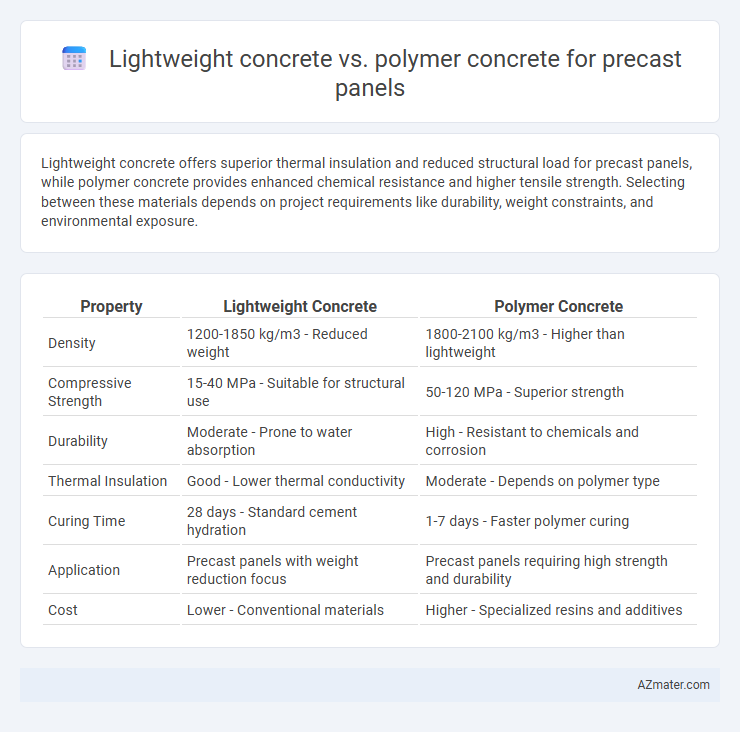Lightweight concrete offers superior thermal insulation and reduced structural load for precast panels, while polymer concrete provides enhanced chemical resistance and higher tensile strength. Selecting between these materials depends on project requirements like durability, weight constraints, and environmental exposure.
Table of Comparison
| Property | Lightweight Concrete | Polymer Concrete |
|---|---|---|
| Density | 1200-1850 kg/m3 - Reduced weight | 1800-2100 kg/m3 - Higher than lightweight |
| Compressive Strength | 15-40 MPa - Suitable for structural use | 50-120 MPa - Superior strength |
| Durability | Moderate - Prone to water absorption | High - Resistant to chemicals and corrosion |
| Thermal Insulation | Good - Lower thermal conductivity | Moderate - Depends on polymer type |
| Curing Time | 28 days - Standard cement hydration | 1-7 days - Faster polymer curing |
| Application | Precast panels with weight reduction focus | Precast panels requiring high strength and durability |
| Cost | Lower - Conventional materials | Higher - Specialized resins and additives |
Introduction to Precast Panels
Precast panels are essential components in modern construction, offering enhanced durability and efficiency. Lightweight concrete provides benefits such as reduced structural load and improved thermal insulation, while polymer concrete excels in chemical resistance and high-strength bonding properties. Selecting between lightweight and polymer concrete depends on specific project requirements, including weight constraints, environmental exposure, and desired mechanical performance.
Overview of Lightweight Concrete
Lightweight concrete, composed of lightweight aggregates such as expanded clay, shale, or slate, offers reduced density and improved thermal insulation compared to traditional concrete, making it ideal for precast panel applications requiring ease of handling and energy efficiency. Its lower weight decreases structural load and transportation costs while maintaining adequate strength and durability for building facades and partitions. Lightweight concrete's porosity and reduced thermal conductivity enhance fire resistance and sound insulation, which are critical factors in precast panel performance.
Overview of Polymer Concrete
Polymer concrete is a high-performance composite material composed of a polymer resin binder combined with aggregates, offering superior mechanical strength, chemical resistance, and rapid curing compared to traditional cement-based lightweight concrete. Its enhanced durability and reduced permeability make it ideal for precast panels exposed to harsh environmental conditions or aggressive chemicals. Polymer concrete panels also benefit from improved bonding and dimensional stability, resulting in longer service life and lower maintenance costs in infrastructure applications.
Material Composition Comparison
Lightweight concrete consists primarily of cement, water, and lightweight aggregates such as expanded clay or shale, offering reduced density and enhanced thermal insulation for precast panels. Polymer concrete incorporates a resin binder, often epoxy or polyester, combined with aggregates like quartz or silica, resulting in superior chemical resistance and higher strength compared to traditional cementitious materials. The key difference in material composition affects durability, weight, and application performance, with polymer concrete excelling in aggressive environments while lightweight concrete emphasizes ease of handling and thermal efficiency.
Mechanical Properties Contrast
Lightweight concrete exhibits lower density and compressive strength, typically ranging from 10 to 40 MPa, with improved thermal insulation and reduced dead loads for precast panels. Polymer concrete, reinforced with polymers like epoxy or polyester, offers superior tensile strength, typically exceeding 50 MPa, higher flexural strength, and enhanced chemical resistance, making it ideal for structural and harsh environment applications. The contrast in mechanical properties highlights lightweight concrete's efficiency in weight-sensitive projects, while polymer concrete excels in durability and load-bearing capacity.
Weight and Density Differences
Lightweight concrete typically has a density ranging from 1,440 to 1,840 kg/m3, making it significantly lighter than conventional concrete, which improves handling and reduces structural load in precast panels. Polymer concrete, with its resin matrix, usually exhibits densities between 1,800 and 2,200 kg/m3, offering higher strength but generally higher weight compared to lightweight concrete. The weight difference affects transportation and installation efficiency, where lightweight concrete precast panels provide easier maneuverability, while polymer concrete panels excel in durability and chemical resistance.
Durability and Longevity
Lightweight concrete for precast panels offers improved thermal insulation and reduced dead load, but its durability can be compromised by moisture absorption and freeze-thaw cycles. Polymer concrete, composed of organic resins and aggregates, exhibits superior chemical resistance, lower permeability, and enhanced durability, resulting in longer lifespan under harsh environmental conditions. The choice between the two depends on specific project requirements, with polymer concrete often preferred for applications demanding exceptional longevity and resistance to aggressive agents.
Cost Analysis and Economic Feasibility
Lightweight concrete offers lower material costs and reduced transportation expenses due to its decreased density, making it economically viable for large-scale precast panel production. Polymer concrete, while featuring superior durability and chemical resistance, generally incurs higher raw material and processing costs, impacting its initial investment feasibility. For cost-sensitive projects, lightweight concrete provides a more budget-friendly solution, whereas polymer concrete suits applications requiring enhanced longevity despite elevated upfront expenses.
Application Suitability in Precast Panels
Lightweight concrete offers superior thermal insulation and reduced self-weight, making it highly suitable for precast panels in high-rise construction where load reduction is critical. Polymer concrete exhibits enhanced chemical resistance and durability, ideal for precast panels exposed to harsh environments or requiring high abrasion resistance. Selection depends on structural load requirements, environmental exposure, and desired performance characteristics in precast panel applications.
Sustainability and Environmental Impact
Lightweight concrete contains natural aggregates and air pockets, resulting in lower embodied energy and carbon emissions compared to conventional concrete, making it a sustainable choice for precast panels. Polymer concrete incorporates resins that improve durability and chemical resistance but relies on petrochemical-based binders, which can have higher environmental impacts and challenges in recycling. For environmentally conscious projects, lightweight concrete offers better sustainability through reduced resource consumption and easier end-of-life recyclability, while polymer concrete excels in performance where longevity offsets its ecological footprint.

Infographic: Lightweight concrete vs Polymer concrete for Precast panel
 azmater.com
azmater.com